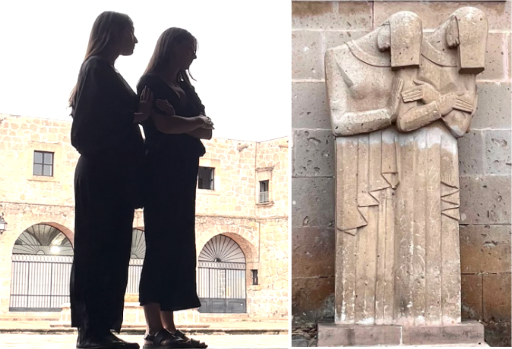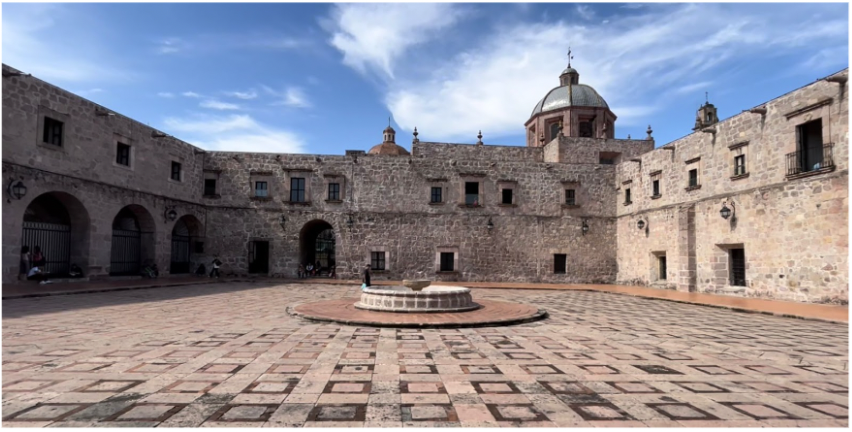Las Plañideras
/The Mourners/
An embodied sound piece directed by body movement

Description: Las Plañideras // The Mourners is a sonic-dance performance that experiments with real-time feedback from a stretch and motion sensor to distort sound samples of ocean waves, embodying the pendulating movement structures that harmonize these waves.
Keywords: Ecological feedback loops, Sonic-Interaction Design, acousmatic music, semantic structures, systemic narratives, reverb, delay, loop, drone

Introduction
Born from our time at the Sonic Visions Academy @ Mexico residency in Morelia, this piece draws inspiration from the cultural, architectural, and natural elements of the city. Coming from a diverse academic background across the fine arts, this was our way of sharing the heart of our journey through sound and movement.
Concept
Las Plañideras is a performance that listens deeply to topographies of bodies; water, human, and the technological systems. In a soundscape directed by body movement, this project experiments with real-time feedback from a DIY stretch and motion sensor to distort samples of ocean waves, playing in forward and reverb motions, embodying the ebb and flow of water states in our current climate and its fluctuating ecological changes. The performers, using subtle motions, act as mourners to water bodies disembodiment, paying particular attention to decades of water consumption that have diminished systems and ecological feedback loops drastically over time.
In the background looms a mix of fixed and dynamic media with an atmospheric composition was arranged with drone, noise and reverb experimentation, paired with some elements of field recordings with the goal of exploring the harmonic structures that exist within these bodies and the interaction between fixed media and interactive/performance based soundscape.


Technical Architecture
Performers Sarah A. and Sarah B. hold a “rope” embedded with both a stretch and motion sensor, working in harmony to capture movement and tension, which then wirelessly transmit data to Max/MSP through OSC using the Particle Argon. The acquired data is scaled and transformed to modulate synth parameters, resulting in stereo output from the loudspeakers.
The stretch sensor generates analog values. In Max/MSP, these values are monitored until they hit a maximum stretch threshold. Upon reaching this threshold, it triggers a playlist of wave crash recordings compiled by Sarah Barone, echoing the water’s sonic crescendos.
In parallel, the motion sensor sends its x,y, and z values for real-time positional interpretation in Max/MSP. When heightened movement is detected, signaling the performer’s active engagement in the space, percussive synthesizer elements are either initiated or silenced.
This sonic element was added to introduce rhythmic depth and variation to the soundscape, as well as to emphasize activity or lack thereof


Field Recordings
As an ongoing part of research on water systems and expressing interrupted and flowing feedback loops, I collected field recordings of the fountains in Morelia, Rivers (which feed into oceans), Ocean waves of the western state of Nayarit (Sayulita, MX). These were integrated into the scoring and real-time sound elements of the work on playback both actual and reverb expressions.
Fixed Media Composition
In the context of the Planideras project and performance, I was tasked with creating the sonic elements of fixed media to accompany the choreography, sounds and to embody the artistic concept of the project through electroacoustic composition. To do so, I focussed on three principal elements within the composition: ambient, calming organ sounds, water sounds, and a sonic structure to act as a guiding force of the choreography. The whole of the composition was arranged using Ableton Live, with the use of sources from different software and recording methods.
The sonic landscape of this collaborative work, before pairing with the live sound generated by the stretch sensor, is a combination of various elements. The previously mentioned ambient sounds including drones, organ sounds, and noise, create a backdrop that mirrors the powerful and calming aspects of water systems, bodies of water construct a first element. To achieve this drone effect, I used the below patch in VCV Rack, a virtual modular synthesis software, to create an organ-like sound that became the drone that can be heard all throughout the composition. I then modified this organ sound using time stretching and pitch shifting to increase the sound depth and in that, that of the performance. After this modification, I layered these sounds with duplicates of themselves to induce phase cancellation and mixed the whole thing with complementary sine tones. This was the first building block of the fixed media.
Next, to complement the wave sounds and other field recordings triggered by the stretch sensor, I added in field recordings I made myself during travel, equally complementing the context of our travel to the field school. These recordings consisted of wave sounds as well as sounds of rain and water trickling, so as to add a variety of water sources throughout the piece. Further, I crafted wave-like sounds using white noise that was enveloped to mimic waves, adding a digital side to the water sounds and mirroring the juxtaposition of humanity and nature as explored otherwise throughout the work.
The drone sounds, layered with other drones of different pitches, water recordings, and wave-like sounds made with noise effected using reverb delay, saturation, and panning, served as the guide for the performers. Sonic events throughout the fixed media worked as signals for the dancers to stretch, move and displace the sensor, as well as to make certain movements or change positions. As such, the fixed media composition and the sonic events triggered by the stretch sensor intermingled and complimented one another, to build a unique sonic environment for the work.


Choreographic Architecture
The choreography uses semantic scoring and inspiration from the sculpture on the west facade of the Cathedral of Morelia. The sculpture was originally placed in a fountain. Having it displaced from its setting of a fountain, as well as the lingering presence of empty water fountains in Morelia (particularly the front of the CMMAS campus) tied into the concept of dis-embodied water systems, something that once flourished is now running dry. Also, the title of the sculpture, Plañideras means mourning which we attribute to the sentiment of the piece which is that of mourning a deteriorating system. The angular shapes of the movement were inspired by it’s Art Deco styles and the draping cloth were embedded into the work as a way to play with tension (ebb) and proximity (flow) which was an extended expression in the triggered sound of the ocean waves when the performers sway together and further apart from one another.
Every element, down to the concealed sensor, serves to maintain the immersion, ensuring the audience feels, rather than merely observes.

Performance x Installation
This project was performed towards the end of the residency at the CMMAS auditorium in August 2023, in Morelia, Mexico.
A video of our performance was later displayed at 4th Space on September 19th as part of the Global Learning Day x Elswhere event. We invited the public to explore the the sensors and watch the performance.


Sarah Al Mamoun
Performer & Creative Technologist
Sarah Barone
Performer, Choreography & Artistic Direction
Georgia Campbell-Irwin
Sound Design